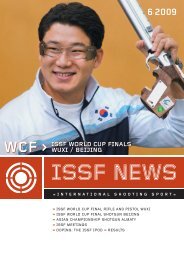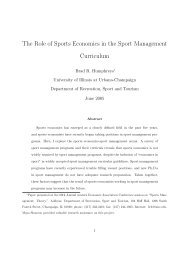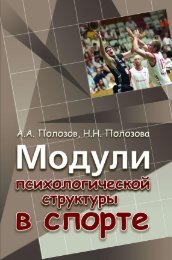Totally Tae Kwon Do Magazine - Issue 17 - Usadojo
Totally Tae Kwon Do Magazine - Issue 17 - Usadojo
Totally Tae Kwon Do Magazine - Issue 17 - Usadojo
Create successful ePaper yourself
Turn your PDF publications into a flip-book with our unique Google optimized e-Paper software.
the art of counter-attack so a foolish<br />
opening attack is sure to lose you a point.<br />
Instead the player has to make feints, and<br />
intimidate his opponent, disturb his Ki, to<br />
create an opening. Only then dares he<br />
attack.<br />
Both Kendo fencing and WTF <strong>Tae</strong>kwon-<strong>Do</strong><br />
sparring are ideally set up for developing<br />
sensitivity to Ki. First, both Kendo and WTF<br />
<strong>Tae</strong>kwon-<strong>Do</strong> uses protective armour. The<br />
armour takes away some of the fear the<br />
practitioner may have of being hit and in so<br />
doing helps the<br />
practitioners to be<br />
more relaxed. Being<br />
relaxed is crucial to<br />
sensing Ki. Seeing as<br />
the practitioner is not<br />
constantly in a<br />
“closed” defensive<br />
posture, he or she<br />
may be more “open”<br />
to experience Ki.<br />
Second, both Kendo<br />
and WTF <strong>Tae</strong>kwon-<br />
<strong>Do</strong> have a very<br />
limited target area.<br />
Since practitioners<br />
need not worry about<br />
too many targets on<br />
their person being<br />
attacked and since<br />
the limited target<br />
areas also narrow<br />
down the scope of<br />
possible attacks from<br />
one’s opponent,<br />
practitioners can<br />
spend more psychological energy<br />
elsewhere. This freed up psychological<br />
energy can be used to anticipate the<br />
opponent’s intention instead. Third, the<br />
initial space between the practitioners is<br />
also big enough for them to feel the energy<br />
between them better. Tokitsu suggests that<br />
in a martial art like Judo where there is no<br />
initial separation of physical contact, there<br />
is hardly any opportunity to “grasp the<br />
intention of your adversary across the<br />
space that separates you” (40). 1 Similarly,<br />
Like the little movements of the shinai tips in the<br />
Kendo match, so the advanced level WTF palyers<br />
move only a little . . . Then suddenly a flurry of<br />
powerful kicks and counter-kicks are exchanged<br />
with deafening gihaps<br />
in full contact Karate or ITF <strong>Tae</strong>kwon-<strong>Do</strong><br />
sparring matches “the combatants<br />
anticipate violent physical contact from the<br />
start, and this tends to galvanize ki inside<br />
the body and prevent its diffusion outward.<br />
Therefore the possibility of opening to the<br />
sensation of ki is limited” (41). It is not that<br />
ITF <strong>Tae</strong>kwon-<strong>Do</strong> cannot develop sensitivity<br />
to Ki in sparring; in fact, one often sees the<br />
same kind of sensitivity in ITF <strong>Tae</strong>kwon-<strong>Do</strong><br />
among the elite competitors who also<br />
seem to “wait” more during sparring bouts.<br />
However, in WTF <strong>Tae</strong>kwon-<strong>Do</strong> such<br />
“waiting” and<br />
anticipation of one’s<br />
o p p o n e n t ’ s<br />
movements are<br />
practically expected,<br />
while in ITF <strong>Tae</strong>kwon-<br />
<strong>Do</strong>’s sport sparring<br />
“waiting” is often<br />
reprimanded by<br />
centre referees giving<br />
warnings to “inactive”<br />
fighters. In order to<br />
make ITF <strong>Tae</strong>kwon-<br />
<strong>Do</strong> more spectator<br />
friendly authorities are<br />
forcing competitors to<br />
be more active in their<br />
sparring. One of the<br />
reasons WTF<br />
<strong>Tae</strong>kwon-<strong>Do</strong> has<br />
come under review by<br />
the Olympic Games<br />
Committee is because<br />
it is not spectator<br />
friendly enough—<br />
there’s not enough<br />
visible action. Those periods of inactivity<br />
are too boring for spectators that do not<br />
comprehend the mental battle happening<br />
before the physical battle occurs.<br />
As an ITF practitioner I am quite interested<br />
in how such Ki sensitivity can be achieved<br />
in ITF <strong>Tae</strong>kwon-<strong>Do</strong>. Following I will discuss<br />
four possibilities: breathing and stretching<br />
exercises, patterns, step-sparring, and<br />
focussed free sparring.<br />
<strong>Totally</strong> <strong>Tae</strong> <strong>Kwon</strong> <strong>Do</strong> - 41

















